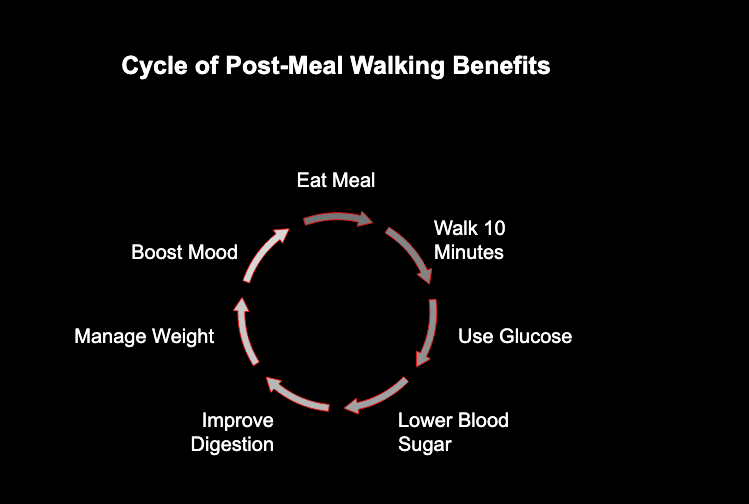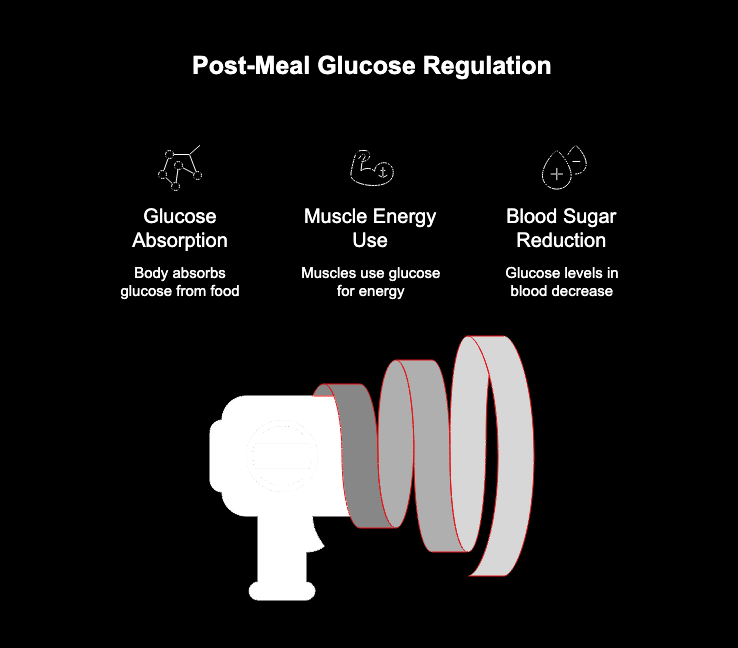
Key Highlights
- A simple 10-minute walk after you eat can help lower your blood sugar. It can also stop blood sugar spikes.
- This short physical activity helps your muscles use glucose for energy. That can reduce the glucose level in your bloodstream.
- Walking after eating is better for blood sugar control than taking one long walk at another time in the day.
- This habit is good for digestion. It also helps with weight management and boosts your mood.
- Even a two to five-minute walk can make a good difference in your blood sugar before your next meal.
- If you have your walks along with a diet high in whole grains, you get even better blood sugar control.

Introduction
Do you want a simple way to take care of your blood sugar? Food matters, but there is another thing that can help all of us. A short 10-minute walk after you eat is proven by science to do good things for your health. This easy walk can help keep the glucose in your blood steady. It stops the drops in energy that come after eating food with sugar, and it helps you avoid health problems over time. A habit like this is easy to pick up and can really help you feel better every day. Let’s talk more about how this can make a difference in your life.
Understanding Post-Meal Blood Sugar Spikes
You may feel tired or in a bad mood after you eat. This can happen if you get blood sugar spikes. A blood sugar spike comes when your blood glucose jumps up fast after a meal. This blood glucose change is usually a normal thing for your body. But if the blood glucose rises often or gets too high, then it can be a real problem.
Over time, the body may have too much sugar in the blood. This can make cells not work well with insulin. Insulin helps move sugar from the blood into cells. When the cells do not use insulin well, there can be trouble.
This can put you at risk for Type 2 diabetes. It also may cause inflammation and make you feel tired all the time.
It is good to know what things make the blood sugar go up fast. When you learn this, you can start to take better control with food and feel good again.

Why Do Blood Sugar Levels Rise After Eating?
After you eat, the digestive system starts to break down carbohydrates. It changes them into glucose, which is a simple sugar. This glucose goes into the bloodstream to give energy to your cells. This is a normal part of digestion for all people.
If you eat a meal that has a lot of refined carbs or sugar, a big amount of glucose goes into your bloodstream quickly. This can make your blood sugar spike. After that, your body uses insulin to move the glucose from your blood to your cells. Because of this, you may feel tired later. The change in your blood sugar causes this crash in energy.
So, how does a 10-minute walk after you eat help lower blood sugar spikes? When you move, your muscles use energy. They get glucose straight from your bloodstream. This physical activity can lower the blood sugar. It keeps the spike from getting too high.
Factors Influencing Glucose Spikes in the United States
Many things can change how bad blood sugar spikes get. The food you eat plays a big part in this. In the United States, people often eat meals with many processed foods and simple carbs. This kind of diet is a main reason for blood sugar spikes.
Frequent spikes are a problem that does not only happen to people with diabetes. A lot of others have it too. This can lead to inflammation and prediabetes. A few big causes for this are:
- Meals that have a lot of refined carbs and sugars.
- Large dish sizes that put too much sugar in the blood at one time.
- Not enough fiber, but fiber usually helps slow down digestion.
Short walks after you eat can help almost everyone lower blood sugar. This is because the way your body digests food and causes blood glucose to go up is the same for all people. When you move your body after a meal, it helps your glucose levels stay in check. It is a good thing to do if you want to improve your health. This habit works well for most of us.
The Science Behind Walking After Meals
The reason a walk after eating works well comes down to simple biology. When you do physical activity, your muscles need energy. They mainly use glucose for this. A walk helps your body use up the sugar from your meal, so it does not stay in your bloodstream.
This easy step can help your blood sugar in a big way. It works in a natural and simple way. You do not need to take medicine or make big changes to your food. You will read more about how it helps your blood sugar and what studies say about this.

How a 10-Minute Walk Impacts Glucose Metabolism
Taking a short walk right after you eat makes your body use more energy. Your muscles need the glucose in your blood at this time. This helps to lower blood glucose, so there is not a sharp spike in it. Your energy levels stay steady, and you avoid feeling tired after a meal.
This way, your body’s insulin works better. When there is less glucose in your blood, the pancreas does not need to make as much insulin. As a result, your insulin can work in a more normal way. This also helps improve your body’s metabolism and keeps you feeling healthy.
Walking for 10 minutes after you eat can help a lot with blood sugar. A study showed that walking after each meal brings blood sugar down better than taking one 30-minute walk at another time of day. Walking for a short time after every meal may work even better than spending half an hour walking just once each day.
Research Supporting Walking for Blood Sugar Control
Many studies show that walking helps manage blood sugar. A 2016 study in Diabetologia found that short walks after eating help more with blood sugar control than just walking at other times. This shows that even a simple walk after meals can make a good difference for you.
The research found that going for a walk for just 10 minutes after eating helped with blood sugar control more than taking one long walk at some other time. A lot of people who use continuous glucose monitors (CGMs) say that their blood sugar readings can drop by about 20 to 30 mg/dL after a short walk. Even taking two to five minutes of walking can help make your blood sugar better.
This shows that when you do physical activity is as important as what you do.
|
Study Finding |
Impact on Blood Sugar Control |
|---|---|
|
10 minutes of walking after each meal |
More effective at lowering 3-hour post-meal glucose than one 45-minute walk. |
|
2-5 minutes of walking after a meal |
Sufficient to positively affect blood sugar levels. |
|
CGM User Reports |
Post-meal walks can lower blood sugar readings by 20-30 mg/dL. |
Best Practices for Effective Post-Meal Walks
To make your post-meal walks really help with blood sugar, you should pay attention to timing and be regular with it. Every bit of movement is good, but following a few easy steps can help your blood sugar management even more. Doing this on a daily basis is a good way to improve your metabolic health.
Just a few minutes of walking after you eat can help you feel better. The time you choose to start and the speed you walk at can really change how much you get out of it. Let’s see how you can make minutes of walking after a meal work best for you.
When Should You Start Walking After Meals?
The best time to start walking after you eat is within 30 minutes. This helps control blood sugar. This is because glucose from the food moves into the bloodstream around this time. A walk right after your meal makes a good difference for your blood sugar levels.
If you walk during this time, you catch the glucose spike before it gets too high. Your muscles use the sugar for energy as the levels are rising. This helps the insulin in your body work better. But, if you wait too long, you will miss this great chance to lower the spike.
To make this fit well in your routine, give these tips a try:
- Set a reminder on your phone about 15 to 20 minutes after you are done eating.
- Begin with one meal each day, like after dinner. Add more later.
- Keep your walking shoes close by so it is easy to go outside.
Walking Speed, Intensity, and Their Effects on Blood Sugar
Do walking speed or intensity matter for reducing blood sugar spikes after eating? You might feel better knowing that you do not need to do a hard workout to get good results. A slow, easy walk can help lower your blood sugar by a lot. The main idea is to make sure you move your muscles after you eat.
Think of this as a easy walk, not a fast race. What matters is that you move your body. You do not need to walk fast. When you move, glucose leaves your bloodstream and goes to your muscles. Because of this, almost everyone can make this a regular habit, no matter their fitness level.
Focus on doing the same thing every day instead of pushing yourself too hard. A 10-minute walk after each meal is easy to do, and it helps your blood glucose level more in the long run. It’s not about one tough workout. It is about choosing something you can keep doing day after day. This way, you make staying healthy a regular part of your life.
Conclusion
Walking for just 10 minutes after each meal can help keep blood sugar spikes under control. It is a simple thing that helps your body use glucose better. This also makes you feel good and supports your health in other ways. Try to make post-meal walking a regular part of your day. A short walk after eating is easy, but it may do a lot to help your body manage sugar levels. The most important thing is to keep doing it, day after day. If you want help and advice that fits you, feel free to ask for a free consultation.
Frequently Asked Questions
Can People With Diabetes Safely Use Post-Meal Walks to Manage Blood Sugar?
Yes, for many people who have diabetes, taking a short walk after eating can help manage their blood sugar in a safe and good way. But it is important to check with your doctor first, mainly if you have kidney disease or other problems. Make sure you watch your blood glucose level. This will help you to avoid low blood sugar, because exercising can cause your body to use insulin faster.


